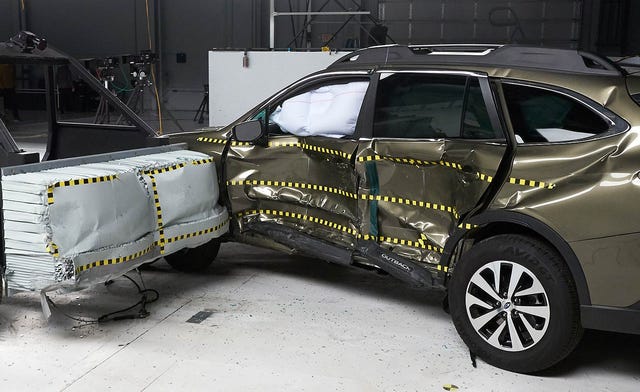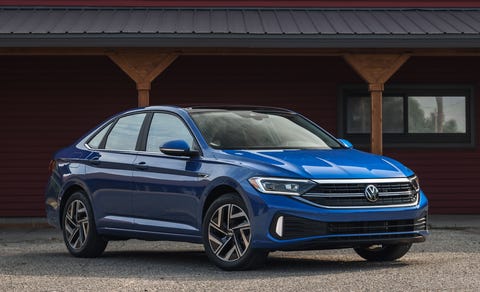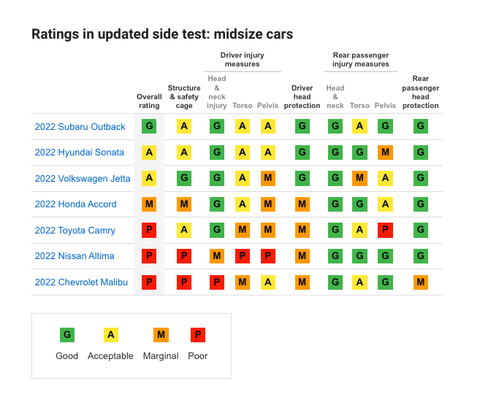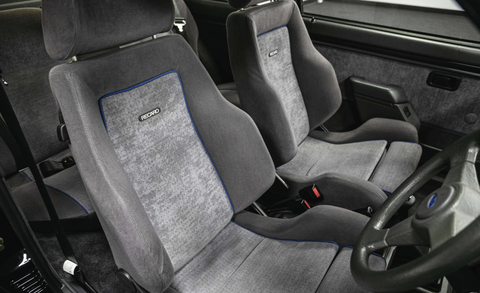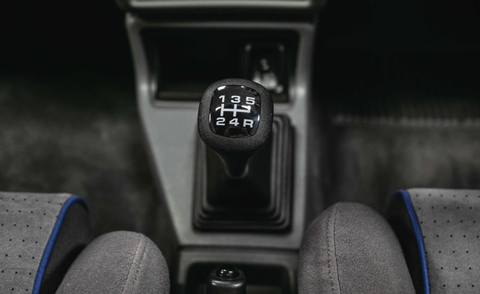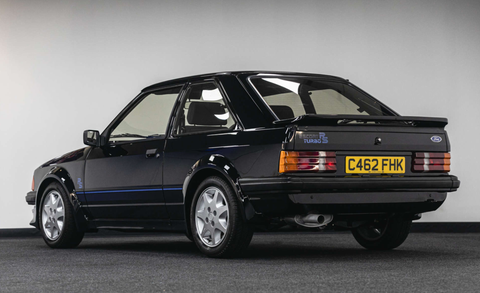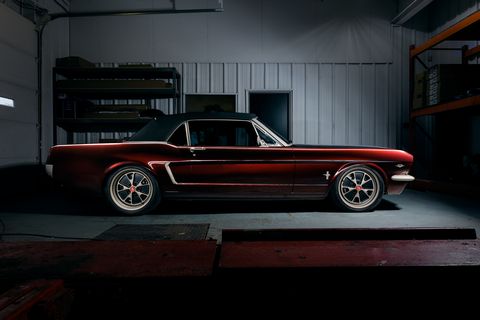2021 Chevy Corvette Long-Term Road Test: 20,000-Mile Update
30,000-Mile Update
Our 2021 Chevrolet Corvette Z51 has done it all. It’s conquered high-mileage road trips up, down, and across the eastern United States. It’s turned laps around multiple racing circuits and been loaded to the gills with oversize items from Costco. Winter couldn’t faze it, and heck, it’s even shock-and-awed unsuspecting hunters with an off-road stint. The only thing left to do is cross the 40,000-mile finish line.
When we last visited our mid-engine superstar, it had emerged from winter with an odometer whose revolutions had slowed. With the warmer season now in full swing, wheels that are round again, and a fresh set of Michelin Pilot Sport 4S sneakers ($1962), the Red Mist Corvette is back to piling on the miles. Our driving impressions haven’t changed—we still thoroughly enjoy every minute behind the wheel. But we’re newly infatuated with the targa top and its ease of use. With lightweight construction, it’s so simple to operate that it can be stowed in the trunk in the duration of a stoplight.
The warmer temps and longer road trips have also helped bring our observed fuel economy up to 19 mpg. We’re still impressed by how the 495-hp 6.2-liter V-8 hums along on four cylinders at highway speeds, and on our 75-mph highway fuel-economy loop, the Corvette returned a respectable 26 mpg.
Alas, the Corvette’s perfect service record was interrupted by a failure on a trip to Virginia. The car traveled to Virginia International Raceway to support our first Lightning Lap track day, and we couldn’t resist the temptation to get out and mix it up with some fellow track rats. With the car rolling on tires that were largely used up and not set into the aggressive track alignment, our laps were more about enjoying our favorite circuit than setting lap times.
It always sad when it’s time to leave Virginia, but when we started the Corvette, we experienced a new kind of heartache. The clutch on the A/C compressor had failed, and upon engagement, it sounded like bolts in a blender and smelled of burning rubber. The Corvette was still drivable, provided the HVAC remained off. The 700-mile trek home was met with cool mornings, searing afternoon heat, and, fortunately, no further issues. Was running the A/C on the track the culprit, or was its failure an untimely coincidence? We’ll never know, but the compressor was replaced at the dealer and covered under warranty.
Our fourth and fifth pit stops for service at 22,500 and 30,000 miles were routine oil-and-filter changes; at the former, a fresh cabin air filter was also installed. To date, we’ve spent $985 on service, a not terribly high sum for a car capable of playing with far more expensive exotics.
With less than 5000 miles to go, it’ll take drastic measures for our opinion of this car to change. For now, we’ll keep doing Corvette things, which is everything.
Months in Fleet: 14 months Current Mileage: 35,563 miles
Average Fuel Economy: 19 mpg
Fuel Tank Size: 18.5 gal Observed Fuel Range: 350 miles
Service: $985 Normal Wear: $2083 Repair: $0
Damage and Destruction: $971
20,000-Mile Update
While in most of the U.S., the year can be defined by four seasons, here in Michigan we experience a few more. We’re talking about the transition periods such as false winter, second spring, pothole season, mud season, and construction season, which bridge the traditional seasons and make our state an interesting yet devastating place for vehicles to call home.
Here, sports cars typically shelter in place in a garage or beneath a cover (or both) for, let’s call it, five months. But not at Car and Driver. Instead, we pilot our Chevrolet Corvette Z51, with its 495 horsepower delivered to the rear wheels, through the coldest, darkest, and most treacherous driving conditions of the year. After all, the Corvette is engineered to survive in these elements.
Bystanders often gave us looks of disbelief when they saw our long-term Corvette dashing through the snow, or perhaps an expression of disgust at the Red Mist livery that had transitioned to a grayish frozen slurry of road grime and a nose full of Michigan’s finest uncut blue road salt. Had they caught a static glimpse of the mid-engine hot rod, they would’ve known the meaty Michelin Pilot Alpin PA4 winter tires fitted at each corner mean business.
When white gold fell from the sky or indecisive clouds slathered the road surface with a glaze of ice, those winter shoes delivered ample traction for assertive throttle inputs. Having 60.4 percent of the Corvette’s 3665-pound curb weight over the rear axle also helps. When the road conditions deteriorate to the friction coefficient of a skating rink, selecting Weather mode via the rotary knob on the center console dials back the throttle sensitivity and the firmness of the shifts of the eight-speed dual-clutch transmission to better tiptoe the Vette through dicey scenarios. When the snow piles up, the front splitter pushes more white stuff than Escobar. But the optional front-axle lift proves effective at clearing speed bumps, and its 1.5 inches of additional lift also help keep the nose clean—provided the speed stays below 24 mph.
When our Corvette was relegated to spending the night outside and freezing precipitation would encapsulate its body in a frozen cocoon, opening the door the following day would emit a gut-wrenching crunchas the rocker panel, door, and fender junction tried to pull themselves from one another. It’s best to remove snow that piles onto the trunklid before attempting to access the rear cargo hold, and using the remote start will allow the furnace that is the 6.2-liter V-8 to help de-ice the tail end. As a bonus, this method ensures the cabin is warm and the heated steering wheel and seats are toasty. Has anyone ever thought of a heated frunk lid? If not, they should, because with no immediate heat source up front, the lid never thaws itself.
Though orange construction barrels have blossomed on the shoulder of nearly every Michigan highway, keeping up with the cycles of freeze, thaw, then freeze again has proved to be difficult. Our Corvette knows this from personal experience. On a nearby interstate, Mother Nature’s jackhammer dislodged a chunk of concrete that the ground-hugging Vette could not clear, ripping apart the front plastic undertray in the process. Thankfully, none of its vitals were damaged during the incident, and we were able to carry on until the $471 repair could be completed.
Our deteriorating infrastructure created more havoc for the Corvette. The crumbling roads leave craters and canyons in their wake, so when the dealer discovered a bent wheel during the winter-tire installation, we weren’t shocked. But all four? Without as much as shimmy in the ride quality, we pulled away scratching our heads. Hats off to the fantastic magnetorheological dampers for tuning out the imperfections, because a second opinion confirmed that all four wheels were indeed out-of-round, and we got them repaired for a reasonable $125 per corner.
Our third service visit proved to be a bit more costly than the bargain ($82) oil change at the 15,000-mile mark. This one includes not only the standard oil and filter change but also transmission-filter replacement and fluid top off as well as a fresh cabin air filter for a grand total of $767. Included in that total is a $222 transmission filter that is apparently constructed of platinum mesh and a quart of transmission fluid synthesized from the finest chemicals that trades for $43.
Now that winter is (maybe) past us, we look forward to getting the Corvette back on proper summer rubber and making the push toward the 40,000-mile finish line. With any luck, those miles will be on smooth pavement under sunny skies. But we’re not counting on it.
Months in Fleet: 11 months Current Mileage: 22,110 miles
Average Fuel Economy: 18 mpg
Fuel Tank Size: 18.5 gal Observed Fuel Range: 330 miles
Service: $849 Normal Wear: $71 Repair: $0
Damage and Destruction: $971
10,000-Mile Update
It’s been pretty easy for our Chevy Corvette Z51 to win us over, with its attention-grabbing lines, agile handling, and blistering 2.9-second sprint to 60 mph. Not to mention the rowdy cold-start bark from its 495-hp 6.2-liter V-8 that Zora Arkus-Duntov probably can hear from the grave. As our long-term Corvette passes the quarter-way point of its 40,000-mile test, we’re finding it difficult to dwell on its often-trivial shortcomings. Instead, we’re growing increasingly impressed with how well this mid-engine sports car works as a road-trip companion.
Since it arrived at Car and Driver HQ, our Corvette’s Michelin Pilot Sport 4S tires have spent little time not in motion. On multiple occasions, it has ferried passengers and their luggage on weekend getaways with few complaints, venturing both to northern Michigan and well south of the state line. The frunk offers enough storage room for a carry-on suitcase and a duffle bag, and the rear trunk can house two carry-ons and whatever else you can stuff back there. Just remember that the trunk is located directly above the exhaust, meaning it gets extra toasty back there and the delicious fudge you’ve purchased on Mackinac Island will melt. “That my wife and I could go on a weekend road trip in the Corvette is perhaps the highest praise I could give it as a sports car,” news editor Eric Stafford wrote in the Vette’s logbook.
Our extended highway drives have also revealed some welcome subtleties about life with the latest Corvette, such as its V-8’s ability to hum along on just four cylinders, even at 80 mph. Though we’ve yet to have any tank of fuel meet the EPA’s 27-mpg highway estimate, our recent excursions have boosted our average fuel economy by 1 mpg, to 18 mpg. What’s more, the gauges—save for the speedometer and engine-temperature and fuel gauges—can be completely blacked out during dead-of-night driving, which greatly helps reduce eyestrain.
In terms of practicality, the Corvette also swallows golf clubs surprisingly well, as associate technical editor Connor Hoffman found when he loaded his in the trunk and headed to St. Louis for a few rounds. However, during a warm afternoon—and presumably to cool off after a weekend of shanking balls into woods—his urge to remove the targa top presented a dilemma: The top easily stows away in the rear trunk, but not with golf clubs or really anything else back there. Likewise, for the few of us who play ice hockey and have come to appreciate the frunks of Porsche’s 718 and 911 models, seemingly engineered to perfectly fit a hockey bag, the Corvette’s front cargo hold is considerably smaller. This has unfortunately led us to cram our wet hockey gear—with its stench—in the cabin. You apparently still can’t have it all with a mid-engine sports car.
Another minor gripe has centered on poor rear visibility, as there are two panes of glass to look through, and both require frequent cleaning to remove dust and water kicked up past the engine bay. Keeping a microfiber towel in the trunk is recommended, but we’ve also learned to bypass the issue by activating the rear-facing camera via a switch on the bottom of the rearview mirror. Though your brain will need to adjust to the camera’s lower perspective relative to the physical mirror, the trade-off is clearer vision and a wider field of view.
Our Corvette has continued to be a reliable machine. The navigation issues that we previously experienced were remedied by a new SD card with the appropriate map data, which was installed during the car’s first scheduled service at 6773 miles. That initial pit stop, which Chevy covers if the first 7500 miles occur within the first three years, includes an oil and filter change, replacing the transmission filter and topping off the fluid, and basic inspections. The second stop, at 15,091 miles, was more routine, requiring an oil and filter change and inspections. We also had the wipers replaced during that visit, bringing our service total to $153.
While our Corvette continues to run smoothly, its biggest challenge may be yet to come as winter weather inundates Michigan. As with nearly all our other long-termers, we recently fitted the C8 with winter tires, OE-size Michelin Pilot Alpin PA4s, in preparation for our first snowy rodeo with a mid-engine Corvette. We’ll report back with our findings in our next update.
Months in Fleet: 7 months Current Mileage: 15,120 miles
Average Fuel Economy: 18 mpg
Fuel Tank Size: 18.5 gal Observed Fuel Range: 330 miles
Service: $153 Normal Wear: $0 Repair: $0
Damage and Destruction: $0
Introduction
We’ve become familiar with the excellence of the eight-generation Chevrolet Corvette, now in its third year of production. It garnered our highest accolade by winning three consecutive 10Best awards, showed its stuff around Virginia International Raceway’s 4.1-mile circuit at Lightning Lap, and narrowly lost a comparison test to arguably one of the greatest sport coupes of the modern era, Porsche’s 718 Cayman GT4. But our exposure has been limited to short time frames, relatively speaking. So we ordered up a C8 for a 40,000-mile long-term test to get a real feel for what it’s like to live with Chevrolet’s mid-engine creation.
Like we often do, staffers butted heads during the order process. One faction argued that this was our one chance to experience a base 1LT Stingray equipped with only the essential go-fast parts that come with the $5995 Z51 package (larger brake rotors, racier suspension tune, dual-mode exhaust, shorter final-drive ratio, electronically controlled limited-slip differential, summer tires) and $1895 magnetorheological dampers for a total of $66,990, the price we always tout as the performance bargain of the century. But we’d be living with our decision for at least a year, and eventually, we settled on the mid-grade 2LT trim (a $7300 upcharge), which includes niceties such as a heated steering wheel and mirrors, heated and ventilated seats, a head-up display, a 360-degree camera, a Bose audio system, wireless charging, and a performance data and video recorder.
While the camera system lends a hand to prevent the front splitter from kissing curbs, we also added the front-axle lift system ($1995) to keep its chin clear of speed humps and driveway entrances. The magnetorheological dampers, Carbon Flash wheels ($995), and enticing Red Mist paint ($995) pushed the as-tested price to a still-reasonable $79,170. We went with interior leather in the Natural tone, a no-cost option that pairs nicely with the deep red exterior.
The first 500 miles of Corvette ownership are subdued. Not by choice, but because of computerized limitations. The redline is reduced to 4500 rpm from 6500, and the eight-speed dual-clutch automatic short shifts whenever it can. This getting-to-know-you phase allows one to become accustomed to the buttons atop the curved wall that separates driver and passenger. At first their location seems odd, but they become easy to operate with more familiarity. With the 495-hp 6.2-liter V-8 in a state of relative dormancy, there’s opportunity to appreciate the Corvette for qualities outside its performance realm. The standard seats are comfortable enough for extended stays yet plenty supportive when the road coils. The adaptive dampers provide a supple ride even over Michigan’s broken pavement, and the Active Fuel Management’s switch to fewer than eight cylinders goes largely undetected.
Once the odometer has passed 500 clicks, the tach opens up and there’s more freedom to explore the engine’s robust power over short stints. After the 1500-mile break-in process, the Corvette sprinted to 60 mph in 2.9 seconds and passed the quarter-mile mark in 11.2 seconds at 122 mph. That’s supercar-level performance for a reasonably attainable price. Not to mention that with the Z51 package’s Michelin Pilot Sport 4S rubber, the car gripped the skidpad at 1.03 g’s. The upgraded brakes stopped our 3665-pound Corvette from 70 mph in a scant 148 feet, and the halt from 100 mph needed just 287.
The miles have piled on quickly, and not surprisingly, the logbook is filling up with praise. “The mid-engine Corvette makes an average Joe feel like Tony Stark in an Iron Man suit,” said buyer’s guide editor Eric Stafford, who added, “Whether it’s parked or in motion, it draws stares.” One staffer loaded it full of hunting gear and took full advantage of the front-axle lift system by navigating a sandy, mile-long two-track back to his cabin. This was after we wisely removed the rear brake cooling ducts that were installed and should be fitted only for track use.
Buyer’s Guide deputy editor and Corvette aficionado Rich Ceppos wrote, “The successor to the original Acura NSX, the everyday supercar, isn’t the current NSX. It’s this Corvette.” But it hasn’t been all praise, although we’re partially to blame by not heeding the warning on Chevrolet’s configurator about windshield glare from the optional interior colors. Though an all-black interior wouldn’t have the upscale appeal of our Natural leather, a black dashtop wouldn’t create the three zebra stripes that reflect onto the windshield.
This content is imported from TikTok. You may be able to find the same content in another format, or you may be able to find more information, at their web site.
So far, the Corvette has been a paragon of reliability—with one exception: The navigation system quit working. For us, it’s not a big deal, as we prefer the mapping apps accessible through Android Auto and Apple CarPlay, but it’s something we’ll have addressed when the car goes in for service. We’ve also added a quart of oil, which isn’t a cause for concern as the pistons, rings, and cylinder walls find matrimony, but it’s something we’ll keep an eye on over the course of the 40,000-mile stay. Perhaps we’ll find more grievances, but so far, Chevrolet’s Corvette has already won us over.
Months in Fleet: 3 months Current Mileage: 5929 miles
Average Fuel Economy: 17 mpg
Fuel Tank Size: 18.5 gal Observed Fuel Range: 310 miles
Service: $12 Normal Wear: $0 Repair: $0
Damage and Destruction: $0
This content is created and maintained by a third party, and imported onto this page to help users provide their email addresses. You may be able to find more information about this and similar content at piano.io

